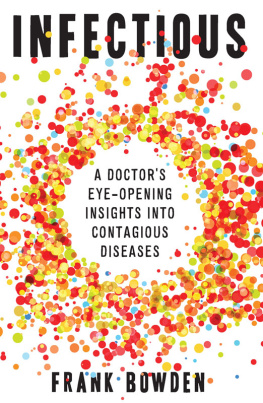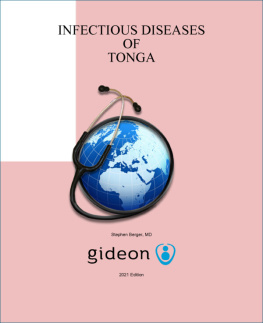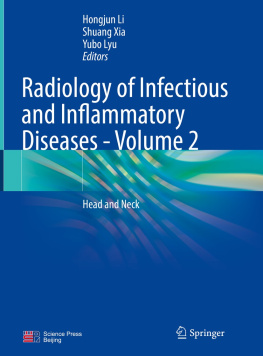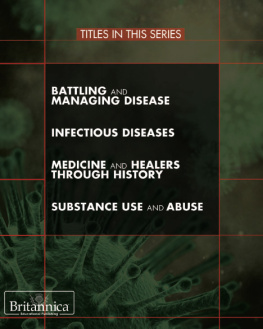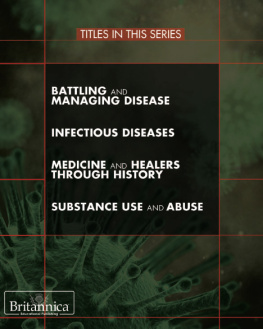Frank Bowden - Infectious: A doctor’s eye-opening insights into infectious diseases
Here you can read online Frank Bowden - Infectious: A doctor’s eye-opening insights into infectious diseases full text of the book (entire story) in english for free. Download pdf and epub, get meaning, cover and reviews about this ebook. year: 2016, publisher: NewSouth, genre: Romance novel. Description of the work, (preface) as well as reviews are available. Best literature library LitArk.com created for fans of good reading and offers a wide selection of genres:
Romance novel
Science fiction
Adventure
Detective
Science
History
Home and family
Prose
Art
Politics
Computer
Non-fiction
Religion
Business
Children
Humor
Choose a favorite category and find really read worthwhile books. Enjoy immersion in the world of imagination, feel the emotions of the characters or learn something new for yourself, make an fascinating discovery.
- Book:Infectious: A doctor’s eye-opening insights into infectious diseases
- Author:
- Publisher:NewSouth
- Genre:
- Year:2016
- Rating:4 / 5
- Favourites:Add to favourites
- Your mark:
Infectious: A doctor’s eye-opening insights into infectious diseases: summary, description and annotation
We offer to read an annotation, description, summary or preface (depends on what the author of the book "Infectious: A doctor’s eye-opening insights into infectious diseases" wrote himself). If you haven't found the necessary information about the book — write in the comments, we will try to find it.
A womans innocuous cold symptoms mask a debilitating rare tick infection. A young man develops shingles then suffers blinding head pain later in life. After years of frustration, a family eradicates head lice forever. Infectious follows on from Frank Bowdens 2011 Gone Viral but deals much more with everyday infectious diseases - the flu, colds, sore throats and head lice. It also tackles topical and critical issues in modern medical practice - the emergence of antibiotic resistance, the Ebola epidemic, the Lyme Disease controversy and the causes of chronic fatigue.Praise for Gone ViralWitty, engaging and poignant Fiona Capp, the AgeAn excellent storyteller Leigh Dayton, the AustralianA wonderful communicator, but also a skilled educator and visionary medical professional Catriona Ooi, Royal Australian College of Physicians NewsA womans innocuous cold symptoms mask a debilitating rare tick infection. A young man develops shingles then suffers blinding head pain later in life. After years of frustration, a family eradicates head lice forever. Infectious follows on from Frank Bowdens 2011 Gone Viral but deals much more with everyday infectious diseases - the flu, colds, sore throats and head lice. It also tackles topical and critical issues in modern medical practice - the emergence of antibiotic resistance, the Ebola epidemic, the Lyme Disease controversy and the causes of chronic fatigue.Praise for Gone ViralWitty, engaging and poignant Fiona Capp, the AgeAn excellent storyteller Leigh Dayton, the AustralianA wonderful communicator, but also a skilled educator and visionary medical professional Catriona Ooi, Royal Australian College of Physicians NewsA womans innocuous cold symptoms mask a debilitating rare tick infection. A young man develops shingles then suffers blinding head pain later in life. After years of frustration, a family eradicates head lice forever. Infectious follows on from Frank Bowdens 2011 Gone Viral but deals much more with everyday infectious diseases - the flu, colds, sore throats and head lice. It also tackles topical and critical issues in modern medical practice - the emergence of antibiotic resistance, the Ebola epidemic, the Lyme Disease controversy and the causes of chronic fatigue.Praise for Gone ViralWitty, engaging and poignant Fiona Capp, the AgeAn excellent storyteller Leigh Dayton, the AustralianA wonderful communicator, but also a skilled educator and visionary medical professional Catriona Ooi, Royal Australian College of Physicians News
Frank Bowden: author's other books
Who wrote Infectious: A doctor’s eye-opening insights into infectious diseases? Find out the surname, the name of the author of the book and a list of all author's works by series.

